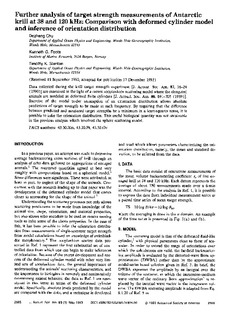| dc.contributor.author | Chu, Dezhang | |
| dc.contributor.author | Foote, Kenneth G. | |
| dc.contributor.author | Stanton, Timothy K. | |
| dc.date.accessioned | 2007-07-04 | |
| dc.date.issued | 1993 | |
| dc.identifier.uri | http://hdl.handle.net/11250/108156 | |
| dc.description | Journal home page: http://scitation.aip.org/jasa/ | |
| dc.description.abstract | Data collected during the krill target strength experiment [J. Acoust. Soc. Am. 87, 16–24 (1990)] are examined in the light of a recent zooplankton scattering model where the elongated animals are modeled as deformed finite cylinders [J. Acoust. Soc. Am. 86, 691–705 (1989)]. Exercise of the model under assumption of an orientation distribution allows absolute predictions of target strength to be made at each frequency. By requiring that the difference between predicted and measured target strengths be a minimum in a least-squares sense, it is possible to infer the orientation distribution. This useful biological quantity was not obtainable in the previous analysis which involved the sphere scattering model. | en |
| dc.format.extent | 359126 bytes | |
| dc.format.mimetype | application/pdf | |
| dc.language.iso | eng | en |
| dc.subject | krill | en |
| dc.title | Further analysis of target strength measurements of Antarctic krill at 38 and 120 kHz: Comparison with deformed cylinder model and inference of orientation distribution | en |
| dc.type | Journal article | en |
| dc.type | Peer reviewed | |
| dc.source.pagenumber | 2985-2988 | en |
| dc.source.volume | 93 | en |
| dc.source.journal | The Journal of the Acoustical Society of America | en |
| dc.source.issue | 5 | en |
| dc.identifier.doi | http://dx.doi.org/10.1121/1.405818 | |
